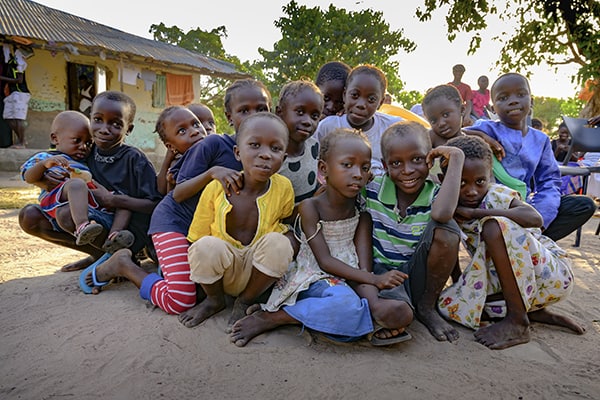Five Steps for Creating Understanding, Empathy, and Action
By Amanda DeWitt

There is no escaping it. Right now we are all touched by the tremendous pain and suffering our world faces. Millions are out of work. Students cannot attend school. Hospitals are full.
It is hard to take it all in — especially for children. But as parents, teachers, and caregivers we can use the current events to teach our kids healthy ways to deal with pain and suffering.
Here are five steps for talking with our kids about difficult circumstances in ways that create understanding, empathy, and positive actions.
1. Talk It Out
We see it on the news. We watch it happen to our family members. We feel it in our own homes.
Sadly, we cannot protect our kids from the realities of a broken world. From the time they are toddlers and beyond, they will struggle with the pain of rejection, death of a loved one, or the difficulty of illness.
The pain and suffering in our world touches all of us. We cannot escape it. But we can learn from it.
When you see a saddened face or are met with teenage silence, do not ignore it. Instead invite conversation.
Talk through struggles as they arise. Give honest answers to tough questions — even when your best answer is that you do not know. Create an open, honest atmosphere where kids feel welcome to talk out their troubles.
2. Break It Down
Always acknowledge when your child faces pain or suffering. Be honest about family struggles or difficulties that impact them. But do it in an age-appropriate way.
Young children do not need, and cannot understand, all the details. So give them the basics. Use simple words they already know to explain an issue. Show them illustrations if appropriate. Relate the issue to a favorite book or cartoon*.
Older children may want more information. So be ready for longer conversations or more questions. Be available for when they may want to talk or bring up an issue. Listen well. Then offer encouragement and validation.
More than anything kids need a safe place where they can receive and process information. You can be the person who will be honest, receptive, and point them to Jesus who ultimately dealt with suffering.
3. Tell the Story
As we help our kids talk through their struggles and process them, we must also help them see the bigger picture. Our personal story* — and the pain and suffering that punctuate it — is part of a bigger story. Our kids need to know the big story about God, humanity, brokenness, suffering, and salvation.
The Bible — God’s grand narrative — shows us the source of suffering, originating in the Garden of Eden when the first humans disobeyed God’s instruction. It illustrates how brokenness is woven throughout human history as people keep straying from Him. At the climax of the story, Jesus enters into our broken world. He experiences our pain. And He pays the ultimate sacrifice for sin on the cross so that we do not have to feel the effects of pain and brokenness for eternity.
A right relationship with God is now possible. And in that relationship, we find not only the explanation for our suffering, but also the solution to it and the redemptive purpose in it.
Tell your kids this story. Open the Bible with them. Help them understand why we suffer, what God has promised, and how we can live out our trust in Him during difficult times.
If your children are young, use Bible story books with illustrations. Read examples of people who experienced God’s protection, overcame fear, and trusted Him despite obstacles. Discuss how these stories apply to their present situation.
Suffering should always point us to our need for our Savior. Share the eternal hope of Jesus with your kids at every opportunity. His story changes our story — and helps us walk through difficult times with hope and joy.
4. Pray Together
Teach your kids to pray about their problems. When fears strike, when feelings overwhelm, when circumstances swirl out of our control, our kids need to know they can always bring their struggles to God.
They need to know that God is a loving Father and a caring friend. He knows our pains. He is moved by our sorrows. He answers His people’s pleas.
But do not just pray for personal issues. Teach your children to pray for others too. Prayer cultivates empathy and teaches us to be moved by the troubles of others. It also allows us to be part of the solution. Prayer is God’s invitation to participate in His answer.
5. Inspire Action
Talk. Process. Read. Pray. Then act.
You cannot choose your circumstances, but you can choose your response. Inspire action by asking your kids questions, brainstorming answers together, and acting on one of your ideas.
How can they have a positive attitude when facing unwelcome situations? How can they encourage someone else who is also struggling? What can they do to be part of a positive solution to their own problem or to someone else’s?
We may not be able to eradicate the Coronavirus right now. But we can make the most of the situation and do our best to serve others who are struggling more than us.
*Two books by Max Lucado can be helpful for processing pain and suffering — for adults, Anxious for Nothing: Finding Calm in a Chaotic World and a board book for kids, Just In Case you Ever Wonder.
URGENT: Survival Kits Needed
Every $35 you give puts critical supplies into the hands of suffering people.
The COVID-19 pandemic has been tough for all of us here in America. But as hard as it has been, the effects of this virus are absolutely devasting in some of the toughest places on earth where people are already struggling with hunger, poverty and war. Requests for critical emergency assistance are now pouring in from our field staff leaders.
Every $35 you give now will put a SURVIVAL KIT into the hands of people who are in dire need of assistance. Each kit will be packed with critical aid like food, masks, hand sanitizer, medical supplies, and hygiene items and will be personally delivered by our local staff members and partners.
Published May 30, 2020

Amanda is a freelance writer whose work has appeared in Gift for Leadership, Kindred Spirit, and Christianity Today publications. She holds a M.A. in Media and Communication from Dallas Theological Seminary.



